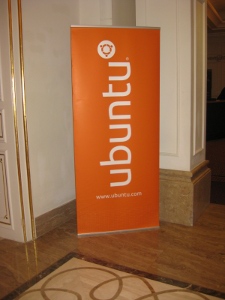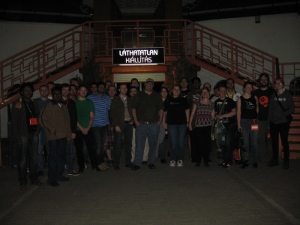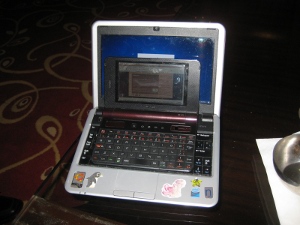I woke up at 5:30AM on Wednesday morning and couldn’t fall back to sleep, once again not enough sleep! After breakfast it was off to the Community Roundtable where we talked about what the 200 million users goal means for the community, nurturing leaders and talked a bit about UDS Sponsorship criteria.
– LoCo and Laptop Testing Review –
I remember when I saw Paolo’s first talk on ISO testing with his LoCo team back in Brussels and I was really excited about it – and promptly failed to ever actually get beyond signing up for the tracker because I did it at the beginning of the cycle before there were any ISOs to test. I revisted the tracker in the Natty cycle while preparing documents for the Global Jam but decided to hold off on jumping in with both feet and using it for the Jam itself. The session was a good one and in addition to covering ISO testing he also presented on the Laptop Testing Tracker. It’s all a really great program and I’m hoping I can work with the California team and reach out to other teams to help them too. Session notes available here.

– Discuss doc team goals for the 11.10 release –
The Ubuntu Docs team truly has a massive scope, handling everything from the official docs, to the plans for help.ubuntu.com, to helping teams improve their pages on wiki.ubuntu.com. Their todo list is very long and I’m happy to see they are moving toward creating a Strategy Document to get some concrete goals. There were also suggestions of small tasks that newcomers can do, which I hope is something that’s pushed to being a vital part of their strategy, like many teams they have a lot of work and volunteers exist but the path to involvement isn’t always clear. Session notes available here.
– Improve monitoring for the Server –
I was hoping the objective of this session would be to review some of the tools being taken into consideration as a follow up to this Nagios thread but it ended up ending after just a few minutes as key people needed to be elsewhere and the direction of conversation was led to “we may change at some point, but Nagios is the standard and we’re going with it.” We use Nagios at work (and I have an install at home monitoring my personal servers) so I wasn’t unhappy with this conclusion, no need to go back to my boss and tell him that we need to change everything for this amazing. awesome new thing.

– Accessibility review of Ubiquity –
Ubiquity is the Ubuntu installer and while mostly accessible there are currently there are a few accessibility problems which this session did a review of and was able to define action items for. These included having the installer make a sound when it starts up, looking into language selection, and making improvements to the slide show so that it’s actually useful for blind users. Session notes available here.
IPv6 has been on my radar for quite some time thanks to discussions I’ve had with MJ these past few months so it was interesting to attend a session where that was the focus. Installations can be a problem where IPv6 is the only connectivity, with the Debian Installer itself still requiring IPv4 (a proposed fix that is being reviewed). There are also considerations around DHCP6 and NFS which they’ll be following up with in QA. It’s great to see all this effort being put in to polish off the IPv6 support. Session notes available here.
– Ask Mark (Q+A with sabdfl) –
For this session Mark brought together several leaders from the community, including Amber Graner, Scott Richie, Jussi of the IRC Council and those of us on the Community Council and invited governance questions from the audience. Decisions about Unity, the retrospectively poor handling of the Banshee situation and other topics were brought up. We have a more formal governance roundtable session on Friday.
From that session it was down to the lobby to meet up with everyone to prepare for the Invisible Exhibition. We had a few cancellations and a few extra people show up but everything worked out well and by shortly after 6:30 we were able to head out. Getting 30 people to the exhibition using public transit was quite the adventure, but members of the Hungarian LoCo Hajnalka Horváth, László Torma and Gabor Kelemen who were guiding us along the way handled it with skill and we made it to the exhbition on time without losing anyone! Hajni had arranged our arrival with the venue so they had English-speaking guides for us and they were able to stay open late to accommodate our whole group.
I took a picture of the exhibition:

Just kidding. But that is what it looked like. The guide took us around a series of rooms where they would ask us to touch things and identify them and throughout asking us questions about how we were feeling, what our impressions are an whether our expectations were different from reality. The tour finished up with us buying drinks in the dark, complete with having to figure out which Hungarian Forint coins we had to pay with (fortunately they warned us beforehand so we could quickly review our coins in the light before going in!).

From there several folks went back to the hotel and the remaining 20 or so of us headed to an Italian restaurant to have some pizzas.
It was after midnight by the time we got back to the hotel and I spent some time talking to people in the casual part of the lobby where I got to play with Emmet Hickory’s tiny Sharp device running Ubuntu which makes my netbook look big!

Of course, it was another late night. On to day 4!

